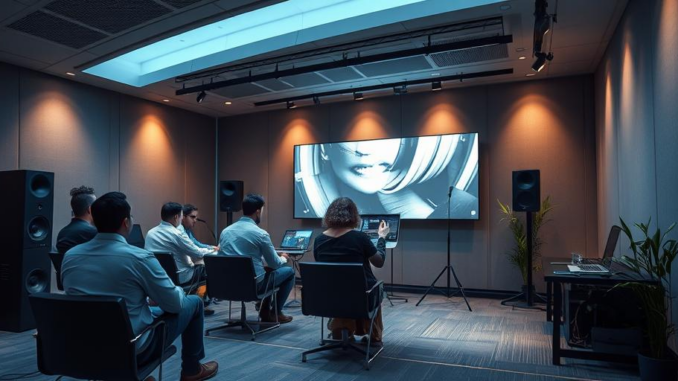
Summary
This article provides a step-by-step guide on how to leverage acoustic solutions to achieve BREEAM certification. It covers key aspects like appointing a qualified acoustician, conducting pre and post-completion testing, and understanding the relevant BREEAM criteria. By following these tips, construction projects can enhance occupant well-being and achieve a higher BREEAM rating.
Discover how Focus360 Energy can help with BREEAM certification.
** Main Story**
BREEAM, or the Building Research Establishment Environmental Assessment Method, it’s basically the gold standard for green building certifications. And you know what? Acoustics are a surprisingly big piece of that puzzle. Believe it or not, a well-designed acoustic environment isn’t just about peace and quiet; it directly impacts occupant well-being, productivity, and even the overall sustainability of your building. So, how do you hit the right notes for BREEAM acoustic credits? Let’s dive in.
First things first: get yourself a qualified acoustician. An SQA, if you wanna get technical. I remember once, on a project years ago, we tried to skimp on this step, thinking we could handle it ourselves, we couldn’t, and what a mistake. An SQA is crucial. They’ll be your guide through the entire acoustic journey, from the initial design sketches all the way to the final testing stages. Think of them as the composer and you’re the builder, if that makes sense.
Next up: the acoustic design report. It’s not just a document; it’s the blueprint for your soundscape. It needs to cover a bunch of critical areas:
- Baseline Noise Survey: Gotta know what you’re up against. What’s the existing noise like around the site? Is it a busy road, a train line, or a tranquil park?
- Noise Limits and Targets: Set some goals! What noise levels are acceptable in different areas of the building? The library will obviously need to be quieter than, say, the cafeteria.
- Construction Specifications: This is where you get down to the nitty-gritty. What materials and construction techniques will you use to achieve your acoustic goals? Think soundproof windows, insulated walls, and resilient flooring.
- Ventilation System Design: This is often overlooked, but ventilation systems can be major noise culprits. Make sure the design incorporates noise control measures, like silencers and vibration isolation.
- Compliance Projections: Will your design actually meet the noise limits? Time to run some simulations and make sure you’re on track.
Before you throw open the doors, pre-completion testing is essential. This is your dress rehearsal, you know? You need to make sure everything’s working as planned.
- Sound Insulation: How well do the walls, floors, and ceilings block sound between different spaces? This is a big one for privacy and preventing disturbances.
- Indoor Ambient Noise Levels: What’s the background noise like inside the building? Is it too loud? Too quiet?
- Room Acoustics: How does sound behave within each room? Is there too much echo? Is the sound clear and intelligible?
So, you’ve done the testing, and maybe, just maybe, something isn’t quite right. Don’t panic! That’s what this stage is for. Work with your SQA to identify the issues and come up with solutions. Maybe you need to add more insulation, adjust the ventilation system, or tweak the room acoustics.
Once you’ve addressed any issues, it’s time for the grand finale: post-completion testing. This is your chance to prove that you’ve met the BREEAM standards. Submit the results as part of the certification process.
Now, I’m not going to lie, the BREEAM acoustic criteria can be a bit complex. You need to familiarize yourself with the specific standards and guidelines for your building type, you can find them online and make sure to check for updates and revisions.
And, for some projects, there’s an extra credit up for grabs: Noise Pollution Reduction (POL 05). This focuses on minimizing noise impacts on the surrounding environment. Think about construction noise, building services, and traffic. The goal is to be a good neighbor, in other words. Who can argue with that?
Finally, just because you’ve achieved BREEAM certification doesn’t mean you can rest on your laurels. Acoustic performance should be monitored and improved over time. Regular checks and maintenance can ensure long-term acoustic comfort and sustainability.
Ultimately, focusing on acoustics is not just about ticking boxes for BREEAM, it’s about creating better buildings for people. When you prioritize acoustic comfort, you’re investing in the well-being and productivity of your occupants, and that’s a win-win for everyone.


The point about ongoing monitoring is excellent. Considering the dynamic nature of building use and external environments, regular acoustic assessments can ensure continued optimal conditions and identify any degradation in performance over time.
I’m glad you highlighted the importance of ongoing monitoring! It’s easy to think of acoustics as a ‘one and done’ solution, but buildings are living, breathing things. Regular assessments, especially after changes in occupancy or external noise sources, are key to maintaining optimal acoustic performance and occupant satisfaction. What are your experiences with this?
Editor: FocusNews.Uk
Thank you to our Sponsor Focus 360 Energy
An SQA is crucial, you say! Sounds like you learned the hard way. I’m imagining a symphony of construction cacophony that could curdle milk. Maybe skimping on the SQA is how new experimental music genres are born?